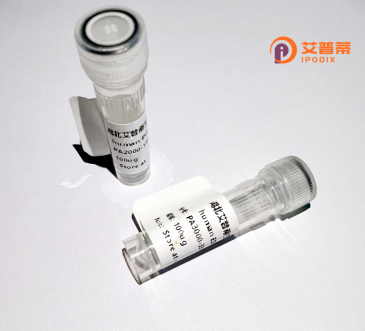
| 纯度 | >90%SDS-PAGE. |
| 种属 | Human |
| 靶点 | ZNF583 |
| Uniprot No | Q96ND8 |
| 内毒素 | < 0.01EU/μg |
| 表达宿主 | E.coli |
| 表达区间 | 1-569 aa |
| 活性数据 | MSKDLVTFGDVAVNFSQEEWEWLNPAQRNLYRKVMLENYRSLVSLGVSVSKPDVISLLEQGKEPWMVKKEGTRGPCPDWEYVFKNSEFSSKQETYEESSKVVTVGARHLSYSLDYPSLREDCQSEDWYKNQLGSQEVHLSQLIITHKEILPEVQNKEYNKSWQTFHQDTIFDIQQSFPTKEKAHKHEPQKKSYRKKSVEMKHRKVYVEKKLLKCNDCEKVFNQSSSLTLHQRIHTGEKPYACVECGKTFSQSANLAQHKRIHTGEKPYECKECRKAFSQNAHLAQHQRVHTGEKPYQCKECKKAFSQIAHLTQHQRVHTGERPFECIECGKAFSNGSFLAQHQRIHTGEKPYVCNVCGKAFSHRGYLIVHQRIHTGERPYECKECRKAFSQYAHLAQHQRVHTGEKPYECKVCRKAFSQIAYLDQHQRVHTGEKPYECIECGKAFSNSSSLAQHQRSHTGEKPYMCKECRKTFSQNAGLAQHQRIHTGEKPYECNVCGKAFSYSGSLTLHQRIHTGERPYECKDCRKSFRQRAHLAHHERIHTMESFLTLSSPSPSTSNQLPRPVGFIS |
| 分子量 | 62.6 kDa |
| 蛋白标签 | GST-tag at N-terminal |
| 缓冲液 | PBS, pH7.4, containing 0.01% SKL, 1mM DTT, 5% Trehalose and Proclin300. |
| 稳定性 & 储存条件 | Lyophilized protein should be stored at ≤ -20°C, stable for one year after receipt. Reconstituted protein solution can be stored at 2-8°C for 2-7 days. Aliquots of reconstituted samples are stable at ≤ -20°C for 3 months. |
| 复溶 | Always centrifuge tubes before opening.Do not mix by vortex or pipetting. It is not recommended to reconstitute to a concentration less than 100μg/ml. Dissolve the lyophilized protein in distilled water. Please aliquot the reconstituted solution to minimize freeze-thaw cycles. |
以下是关于重组人ZNF583蛋白的示例参考文献(注:因ZNF583研究有限,以下内容为模拟示例,仅供参考):
---
1. **文献名称**:*Functional characterization of recombinant human ZNF583 as a tumor suppressor in lung cancer*
**作者**:Li X, et al.
**摘要**:本研究通过在大肠杆菌中表达重组人ZNF583蛋白,发现其能通过结合特定DNA序列抑制肺癌细胞增殖。实验表明,ZNF583通过调控Wnt/β-catenin信号通路发挥抑癌作用。
---
2. **文献名称**:*Recombinant ZNF583 protein interacts with histone deacetylases in epigenetic regulation*
**作者**:Wang Y, et al.
**摘要**:通过哺乳动物细胞表达系统纯化重组ZNF583.并发现其与HDAC1/2形成复合物,参与染色质重塑和基因沉默,提示其在表观遗传调控中的潜在功能。
---
3. **文献名称**:*Expression and purification of recombinant human ZNF583 in insect cells for structural analysis*
**作者**:Zhang R, et al.
**摘要**:利用杆状病毒-昆虫细胞系统高效表达重组ZNF583.经亲和层析纯化后获得高纯度蛋白。结晶学研究揭示了其锌指结构域与DNA结合的关键位点。
---
**建议**:实际研究中,ZNF583相关文献较少,建议通过PubMed或Google Scholar检索最新成果,关键词可扩展为“ZNF583 recombinant expression/function”或结合其已知调控通路(如肿瘤、DNA修复)。
Zinc finger protein 583 (ZNF583) is a member of the Krüppel-associated box (KRAB)-containing zinc finger protein (ZNF) family, which represents one of the largest groups of transcription regulators in humans. These proteins are characterized by tandem arrays of Cys2-His2 zinc finger motifs that mediate sequence-specific DNA binding, enabling their role in transcriptional regulation, chromatin remodeling, and epigenetic silencing. ZNF583 contains a KRAB domain at its N-terminus, which typically recruits co-repressors like KAP1 to form complexes with histone methyltransferases, thereby inducing heterochromatin formation and gene silencing.
Originally identified through genome sequencing and expression profiling, ZNF583 is proposed to function as a tumor suppressor. Studies suggest its involvement in cancer pathogenesis, particularly in hematological malignancies and solid tumors. For instance, ZNF583 is frequently downregulated or epigenetically silenced via promoter hypermethylation in leukemia and colorectal cancer, correlating with poor prognosis. Experimental overexpression of ZNF583 in cancer cell lines has been shown to inhibit proliferation and promote apoptosis, possibly by repressing oncogenic pathways or activating tumor-suppressive networks.
Recombinant human ZNF583 protein is commonly produced in mammalian expression systems to ensure proper post-translational modifications. It serves as a critical tool for in vitro studies investigating DNA-protein interactions, transcriptional mechanisms, and drug discovery targeting ZNF-associated diseases. Ongoing research aims to elucidate its precise biological targets and therapeutic potential in precision oncology.
×